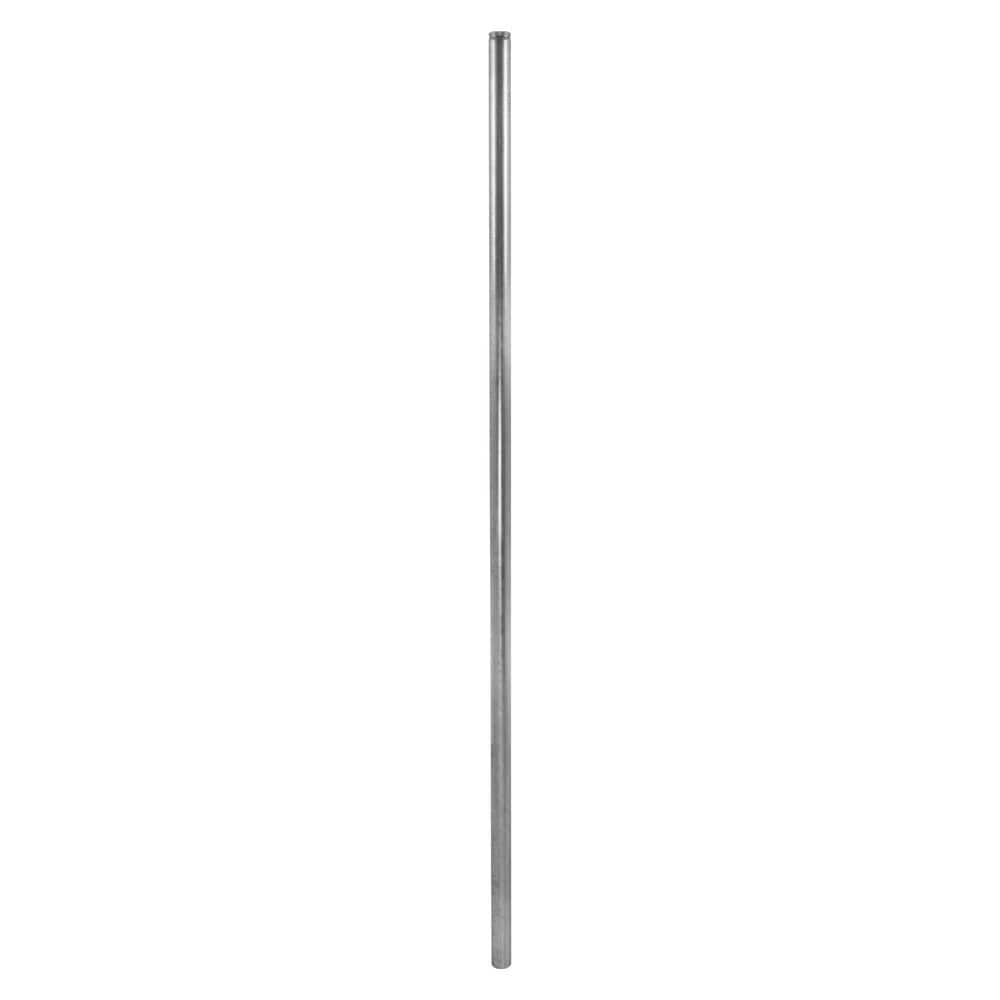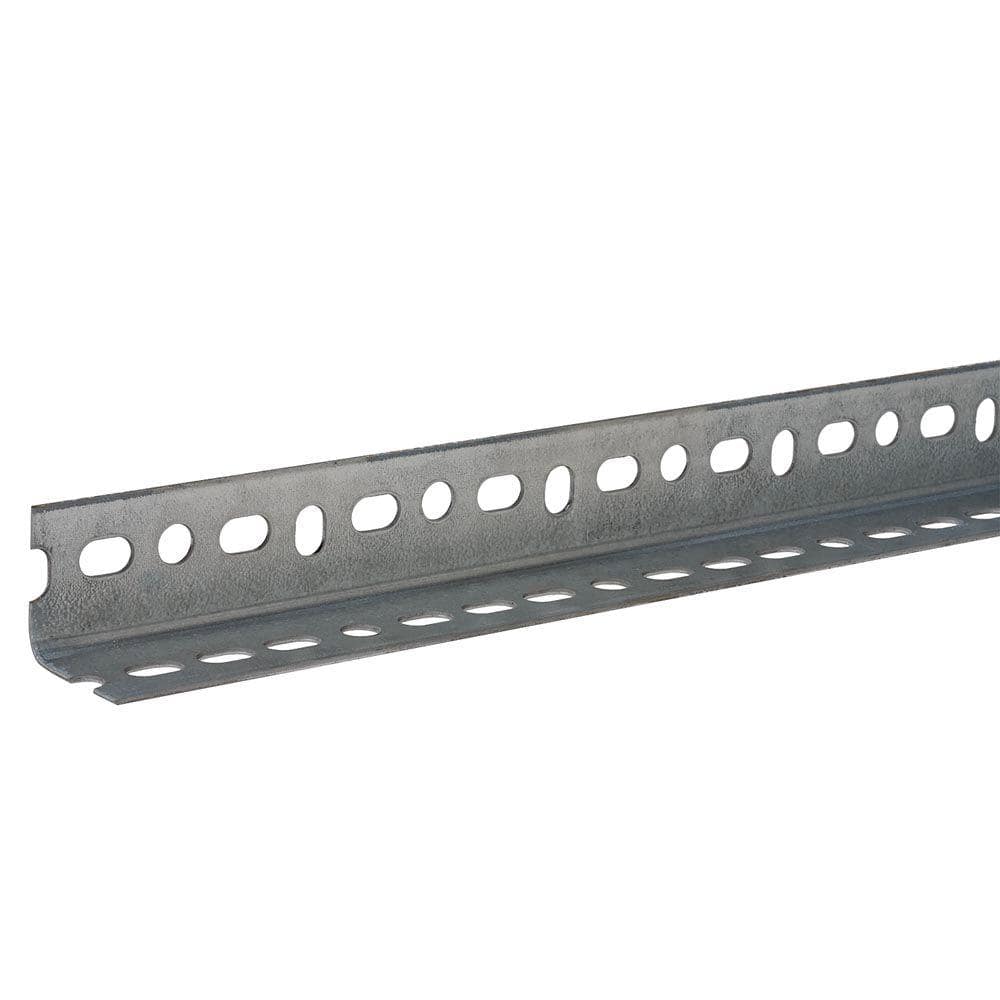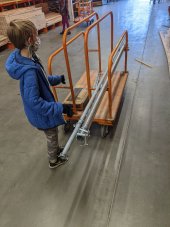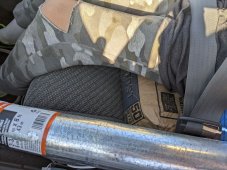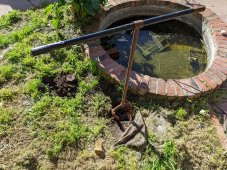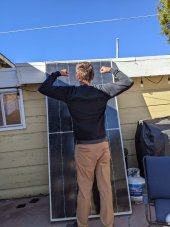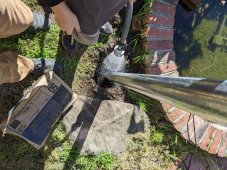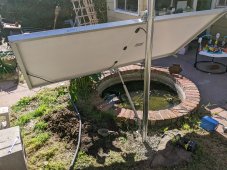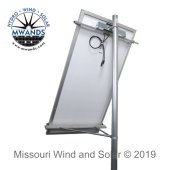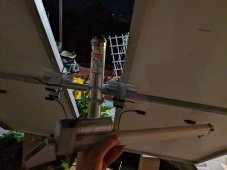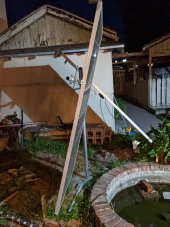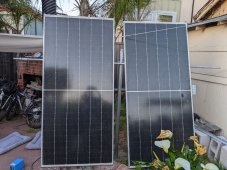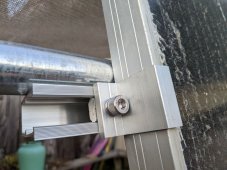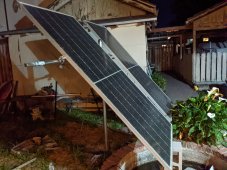methods
New Member
- Joined
- Dec 6, 2021
- Messages
- 173
RESUME SIMULATED EMERGENCY
Ok, I am doing it.
* Gonna use the smaller diameter 1 5/8" 6' pole, like $12 bucks and in stock
* Going to sink that 2.5' into the earth in my back yard... leaving 3.5' for a panel that is 40.5" wide, on the ground!
This means there can be
* No weeds
* No bumps in the earth
* Ok, we are on a very steep slope in the final end-run
What do we have so far?
* Pole poking out of the ground three and a half feet
* Panel that is 3 and a half feet wide, on its side
* We are in for under $20/460W module so far
U-Bolt clamps are cheap
Top caps are cheap - today - lets go with a NO WELDING REQUIREMENT... since this is a Knock-Together emergency simulation.
* U-Bolt at the top, single
* Bolt a hinge to that
* Tapper-Screw the hinge into the panel, center
* Back the panel (86" or 7.2' or 2182mm) wide with a stiffener with 2 points of attachment***
So in this case, we affix to the pole at a single point, but the stiffener attaches to the panels at two points along the top... so it will wiggle a bit, but the panel wont be flexing at the middle. Stiffener can be VERY light gauge steel or aluminum now, since we can "punch it thru" along the way for multiple points of attachment. The stiffener just has to go "long side" against the worst bend, so 1" should do it.
What do we have now
* 6' pole in the ground, 3.5' exposed
* U-Bolt at the top (DOH - Ran out of pole)
What do we have now
* 6' pole in the ground, 4' exposed, more concrete which is cheap and easy
* U-Bolt at the top, hinge attached, stiffener attached - at least 4' of L bracket, at least 1", at least 1/16 aluminum or 14G steel
* Panel could now be affixed and hang vertical, bottom could be propped up with a bucket or piece of wood
What are we in for? Definitely under $42 - way under. Possibly under $21, but likely only if we buy larger stock and cut it down. I have 4" grinder cutter wheels but we need to buy some more. I gave away my chop-saw so we need to go to Harbor Freight, or just cut aluminum with my wood saw, or... we will just angle-grind the damn steel backers. OK....
What are the Trigonometric realities of that?
* Needs to be near vertical this time of year
* Needs to lean up quite a bit for summer
* Looks like it can rotate no problem
What about shading at different angles?
* Wont matter in summer, they could go side to side
* Turned, in winter... eh... better be careful!
So what does it cost to move a post once it is set? Not much right? Ok, move forward
-methods
Ok, I am doing it.
* Gonna use the smaller diameter 1 5/8" 6' pole, like $12 bucks and in stock
* Going to sink that 2.5' into the earth in my back yard... leaving 3.5' for a panel that is 40.5" wide, on the ground!
This means there can be
* No weeds
* No bumps in the earth
* Ok, we are on a very steep slope in the final end-run
What do we have so far?
* Pole poking out of the ground three and a half feet
* Panel that is 3 and a half feet wide, on its side
* We are in for under $20/460W module so far
U-Bolt clamps are cheap
Top caps are cheap - today - lets go with a NO WELDING REQUIREMENT... since this is a Knock-Together emergency simulation.
* U-Bolt at the top, single
* Bolt a hinge to that
* Tapper-Screw the hinge into the panel, center
* Back the panel (86" or 7.2' or 2182mm) wide with a stiffener with 2 points of attachment***
So in this case, we affix to the pole at a single point, but the stiffener attaches to the panels at two points along the top... so it will wiggle a bit, but the panel wont be flexing at the middle. Stiffener can be VERY light gauge steel or aluminum now, since we can "punch it thru" along the way for multiple points of attachment. The stiffener just has to go "long side" against the worst bend, so 1" should do it.
What do we have now
* 6' pole in the ground, 3.5' exposed
* U-Bolt at the top (DOH - Ran out of pole)
What do we have now
* 6' pole in the ground, 4' exposed, more concrete which is cheap and easy
* U-Bolt at the top, hinge attached, stiffener attached - at least 4' of L bracket, at least 1", at least 1/16 aluminum or 14G steel
* Panel could now be affixed and hang vertical, bottom could be propped up with a bucket or piece of wood
What are we in for? Definitely under $42 - way under. Possibly under $21, but likely only if we buy larger stock and cut it down. I have 4" grinder cutter wheels but we need to buy some more. I gave away my chop-saw so we need to go to Harbor Freight, or just cut aluminum with my wood saw, or... we will just angle-grind the damn steel backers. OK....
What are the Trigonometric realities of that?
* Needs to be near vertical this time of year
* Needs to lean up quite a bit for summer
* Looks like it can rotate no problem
What about shading at different angles?
* Wont matter in summer, they could go side to side
* Turned, in winter... eh... better be careful!
So what does it cost to move a post once it is set? Not much right? Ok, move forward
-methods



